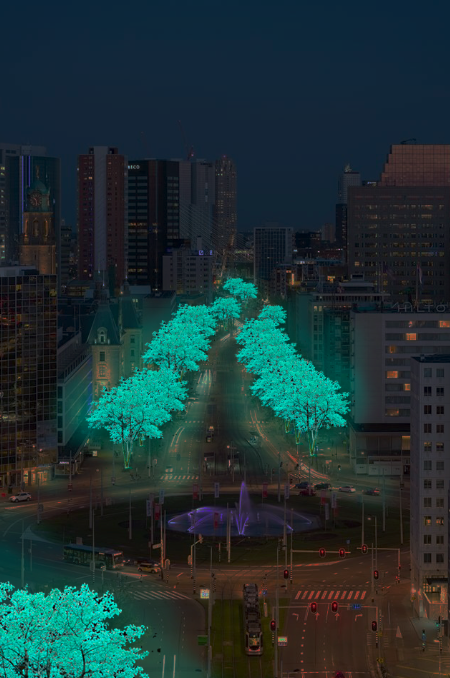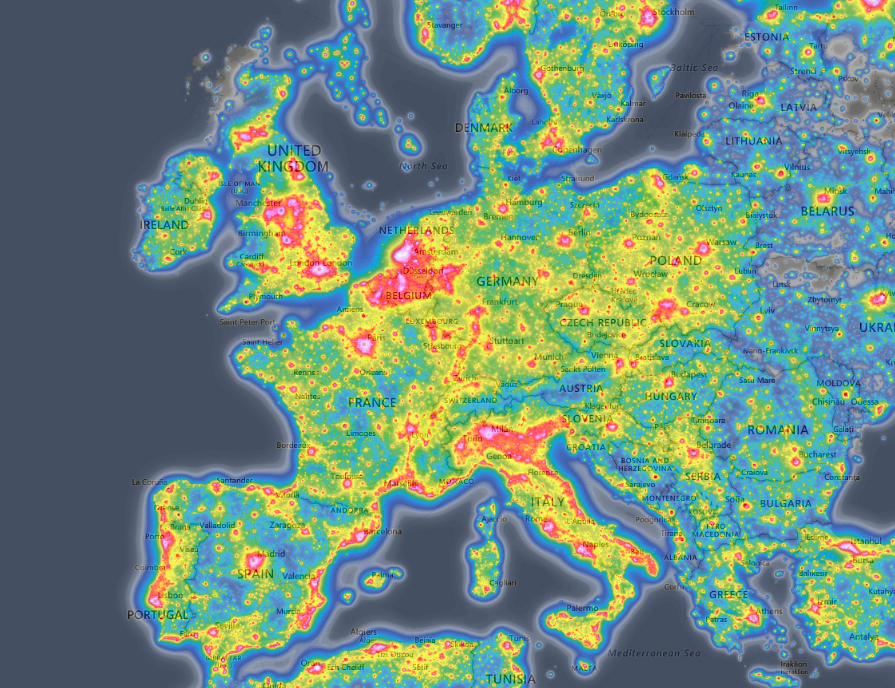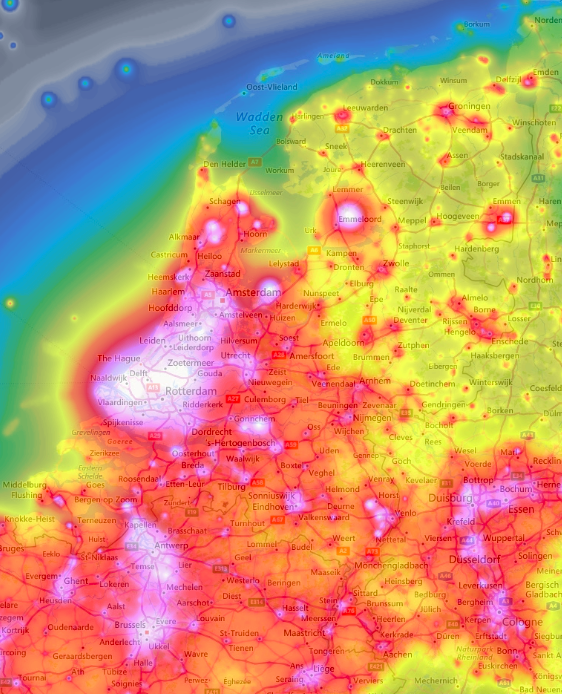Maël van der Giesen
Spatial Design 2
New
Earth
Bioluminescence is, what they call, Cold Light. This means that less than 20% of the light generates warmth or heat. Unlike a light bulb, this means that bioluminescence is a highly efficient light generator.
To produce light this reaction needs two chemicals: Luciferin and luciferase or photoprotein. Luciferin is the chemical that produces the light.
Source: National Geographic
https://www.nationalgeographic.org/encyclopedia/bioluminescence/
When the evening comes closer and the sun starts setting, streetlights will take over the task to illuminate cities. Methods to do this have evolved over the years. For a long time fire has been the main source of light and torches or oil lamps would therefore fit the job perfectly. But, it wasn't until the 17th century that cities started to really implement fixed lanterns in their streets. From there, new sources of light were found such as gas lamps (which used coal gas), arc lamps (which used carbon) and the well-known light bulb (which worked based on gas-discharge).
Nowadays, new and more efficient forms of light are being experimented with. LED is a common one and is more and more used for streetlights. However, it's still artificial light source. 70% of the electricity worldwide is generated by burning fossil fuels. This is an enormous percentage and is something that really needs to be reduced. Nowadays, countries are dimming or even turning off lights during specific hours in certain area's to reduce this use of electricity. These are of course solutions for now, but not for the long run. We should therefore look for alternative lights sources.
In nature you find examples of sources of light due to specific bacteria and the chemical reaction around Luciferin and Luciferase. When these two meet and react with each other in combination with oxygen it generates energy in the form of light. Studying these forms of natural light sources can possibly provide us with possibilities to create and generate light from replenishable resources instead of using fossil fuels of which we'll eventually run out. The combination of biology, science and design is, in my humble opinion, probably the best way to approach system thinking to create a new earth.
Some organisms produce luciferin themselves which results in light. However, organisms do not need to necessarily produce it themselves to use it. In some cases Luciferin can also be absorbed through other organisms by, for instance, eating them. Housing bacteria is also a way of not producing the chemical actively, but still being able to use it.
Luciferase
+
Oxidized Luciferin
=
Oxyluciferin
Enzyme
Substrate
Luciferase can be replaced by photoprotein.
The appearance and colour of the light can differ depending on the habitat of the organism. Also the consistency of emitting light differs from organism to organism.
GFP is a bioluminescent chemical. It can easily attach itself to another gene without interfering with its behaviour.
Use in nature
Bioluminescence is rare and can not be found in that many species. Above the ground the most common species that produce light due to luciferin are fireflies, some larvae and a variety of fungi. However, most organisms that are able to use it can be found in deep sea waters like anglerfish, jellyfish and some squids for instance.
But why do these organisms have this ability? What do they use it for? The answer to this question really depends on the specific organism. But as you can see in the scheme on the right there are 3 main goals that can be found in nature:
Defense, to make sure they are not eaten.
Offense, to lure other species so they can eat.
Reproduction, to attract others.
So besides the fact that it looks nice, the luminescent property is a key element when it comes to the survival of these organisms. It's not coincidence that these creatures have this ability, it was evolution that made sure this ability stayed and evolved within these species. This why most organisms who use this are sea creatures, since light is a very useful tool when it comes to living in dark and deep waters.
What?
Why?
Source: National geographic
https://www.nationalgeographic.com/animals/reference/bioluminescence-animals-ocean-glowing/
How?
Source: The Conversation
https://theconversation.com/what-is-bioluminescence-and-how-is-it-used-by-humans-and-in-nature-100472
More than 75% of seacreatures are expected to be able to produce their own light due to bioluminescence
Glowing bacteria can be replenished quite fast. Squids, for example, will use 95% of their bacteria. Then they nourish the remaining 5% so they will grow during the day and start glowing again when the sun sets.
Some of the bioluminescent bacteria use quorum sensing. This means that the genes "count" how many there are and will not start glowing before there are enough. This results in a very efficient light distribution in which no energy is wasted.
The bioluminescence created by plankton is activated in flashes of light (instead of a constant glow) as a reaction to movement.
&
Bypoduct
Light
Bioluminescence is more and more used by humans. Fireflies, for instance, were used as light sources for torches in mines. Nowadays, scientists start to see the potential of it being a new source of eco-friendly energy.
Research
Projects
World gross electricity production, by source, 2017
Coal (38%)
Natural Gas (23%)
Nuclear (10%)
Oil
(3%)
Hydro (16%)
Wind
(4%)
|
Solar
(2%)
Biofuel
& Waste
(2%)
|
Geothermal, Tidal,
Other
(1%)
|
As you can see in the table above an absolute majority, 64%, of the generation of electricity still comes from fossil fuels. Only 25% comes from eco-friendly and replenishable resources. We need to focus more on new resources. Resources that do not have bad consequences for the environment and for public health. By looking at nature and practicing more biomimicry we could learn and develop a lot of new methods to generate bio-friendly electricity.
The past years we see a rise in usage of LEDs and its expected that in 10 years they make up for almost 80% of the light sources. This is, of course, amazing. However, trying to imply natures way of generating light due to bacteria and therefore create fully natural light would be an even bigger improvement. If we as a species are able to look at nature, like bioluminescence, and copy this we could create and use incredible green resources that will provide electricity for future generations and a harmonious co-relatedness with our planet.
Source: IEA
https://www.iea.org/data-and-statistics/charts/world-gross-electricity-production-by-source-2017
Source: IEA
https://www.iea.org/fuels-and-technologies/lighting
Nova Innova
Living Light
Nova Innova is Dutch team of designers and developers who have teamed up with the goal to create and develop a bridge between science and everyday life. They develop sustainable applications in the form of a powerful design to work towards a future that consists of clean air, water and energy.
One of their projects is called Living Light. With this project they aspire to create a world in which plants become part of our energy system and where technology and nature will merge. Living Light is a lamp, which harvests its energy through the photosynthetic process of the plant. The light will be activated by softly touching the plant. The available amount of energy depends on the well-being of the plant.
Reference
Living Light uses microbial fuel cells. Due to photosynthesis, plants release organic compounds which are then broken down by bacteria to release electrons and protons. These electrons are then captured and transferred through a wire. This generates electricity. They then are dropped back into the ground in their natural system. The electricity 100% generated by a natural system using this microbial fuel cells.
The electricity that is harvested will be stored into a little leaf. When you touch the plant the energy will be released and the LEDs in the ring start to shine. This creates an interaction with the plant which then leads to light.
Obviously, this system will work best when the plant is looked after well, thus also touching the subject of looking after nature.
All the facets of the product are chosen to try and make it as sustainable as they can:
- The holder in which the LEDs are placed is made out bamboo.
- The planter holds te microbial fuel cell.
- The leaf that sticks in the ground houses the harvested energy. In that way the energy is only released when you touch the plant.
- The glass is handblown.
Daan Roosegaarde
Bioluminescence
Glowing Nature
Daan Roosegaarde is a dutch artist/designer who used bioluminescent algae in his project Glowing Nature. For months he experimented with one of the most light emitting algae in the world. He created a space in which the conditions for the algae were best, thus generating lots of light. They are placed on the floor, so when you walk on them they will shine due to the movement. With this project he wanted to explore the possibilities of light sources directly from nature.
This is a nice starting point of studying how to use this light source and under which circumstances they have the best outcomes. The next step would be to use this outside of an art gallery.
Teresa van Dongen
Ambio
Teresa van Dongen created a lamp after having experienced the bioluminescent lights of algae on the shores.
Ambio balances two weights and a glass tube half-filled with a "Artificial Seawater Medium" containing a carefully selected type of these unique luminescent species. Give the lamp a gentle push every so often and the weights will keep it moving and thus glowing. Ambio is a visualization of a research on how to use nature as a source of energy.
Theory
Iceberg Model
Implementation
Due to my chosen waste product essentially being industrially manufactured inefficient energy I found it hard to make try-outs or experimentations. In my opinion, in the near future, these sources of energy, and thus light, should be completely substituted by natural sources of energy. 1/4 of the electricity generated goes to lightning, imagine the cuts we could make in electricity consumption if we found substitutes for artificial light. I feel like there are a lot of possibilities in using already existing natural systems, bacteria and chemical reactions. The planet generates electricity in a lot of ways. Just like we see in the living light project of Nova Innova, they research the possibility of generating electricity using natural processes that already exist without human intervention. Of course there's a lot of research that needs to be done about these uses. But I believe that if we create a focus on this resources we will eventually be able to copy natural systems and eventually generate bioluminescence ourselves. This would mean that instead of having to use products that produce waste, we will start using 100% natural and eco-friendly sources of light.
Using bioluminescence can be a key in a new way of energy using and light generation. However, 4 weeks is too short to be able to test and produce products since this means that I'd need, besides luciferin, luciferase or types of algae, some more knowledge about biological and chemical properties of bioluminescent organisms. Nonetheless, I can make a plan for how I would realise this project if i'd have more time.
First of all, I would not to this on my own. Within this project I'd need people around me with expertise of different facets of the project.
I'd try and get in contact with some biologists which have already been studying the way bacteria behave and have a large base knowledge in the field of biology.
Then I'd also want to speak and collaborate with chemists. They can provide information and knowledge about the specific chemical reactions that produce light and how to ameliorate those reactions in such a way that we can maximise their effects.
It might be a good idea to also get in touch with the TU Delft. They often collaborate in projects like this and i think that their expertise will definitely be a helping hand in the developing process of this project.
Some juridical help might also be of use since there are some legal restrictions regarding working with bacteria.
Team planning
Proposal I
Cities during the night produce a lot light. Even if they would only use LEDs, 20% waste is a lot regarding the amount of light produced in urban landscapes. Bioluminescence is the perfect fully natural way of producing light:
- It has a 100% efficiency level, which means that pretty much all the energy is turned into light.
- It's generated by a luciferin and luciferase which are replenishable resources.
- It does not produce a waste product that we have to throw away after it's been used.

It would be revolutionary if we'd able to implement the chemical reactions that cause organisms to produce bioluminescence into plants or bacteria so that we can produce these light sources.
Imagine creating bioluminescent plants for in the city centre of Rotterdam. This would mean less lanterns that waste energy, more trees in the city; thus creating a greener city.
The harbour and the car dominated city centre produce a lot of pollution. So combining streetlights and plant life means more plants in the centre, which then results in more oxygen in a city that is surrounded by polluting sources.
Rotterdam and its surroundings are amongst the areas with the highest light pollution in the world. The bioluminescent light are a bit dimmer than artificial light. So using this could maybe make sure that citizens of Rotterdam can finally find out what stars are.
+
Proposal II
Instead of combining it with already existing organisms, like trees, plants or algae, we can also try to create structures that resemble lanterns. However, instead of making them out of metal in which we place one light source at the top; we try to find out how to make the whole structure will be covered, or made with the bacteria that are combined with luciferin and luciferase. Like this we are able to place these structures wherever we want in the shapes that suits the place best. So also on spots where there's no place for trees.
This proposal needs further research:
- What kind of bacteria could we grow that are suitable for creating strong enough structures?
- How can we combine the chemicals with these bacteria?
- How can we use this bioluminescent structure to work to its full potential?
It would result in "glow in the dark"-structures that operate as lanterns in the city. Except, since they are made out of the organic bioluminescent material they can provide themselves with light emitting qualities instead of having to get this energy from artificial light sources.


Light pollution of Europe and the Netherlands
Light pollution is excessive, misdirected, or obtrusive artificial (usually outdoor) light. Too much light pollution has consequences: it washes out starlight in the night sky, interferes with astronomical research, disrupts ecosystems, has adverse health effects and wastes energy. With respect to energy wastage, lighting is responsible for at least one-fourth of all electricity consumption worldwide. Over illumination can constitute energy wastage, especially upward directed lighting at night. Energy wastage is also a waste in cost and carbon footprint.
As you can see on the maps above the area of Rotterdam is one of the most light polluted areas of Europe. This is due to its harbour, lots of greenhouses and a high population density. Looking for new methods of light is therefore an important part for this urban area.
Source: Light Pollution Map
https://www.lightpollutionmap.info/#zoom=6.569057946782699&lat=6777181&lon=580849&layers=B0FFFFFTFFFFFFFFF
Source: Globe at night
https://www.globeatnight.org/light-pollution.php
ATP
+
System mapping